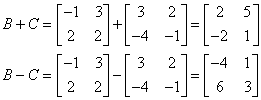 username@email.com
username@email.com
In this lesson, you will review matrices and their operations. You will also identify the properties of operations on matrices and explore inverses.


There are no surprises in addition and subtraction of matrices, however there is one requirement. The matrices must have the same dimensions. Once you establish that the matrices you are working with have the same dimensions, you can add or subtract each entry in the first matrix with the corresponding entry in the second matrix.
The sum and the difference of matrices B and C are shown below.

The correct choice is B. Add each entry ij of J to the respective entry ij of K, and subtract the respective entry ij of L.
What are the dimensions of the matrix J in the example above?
The correct choice is D. The dimensions of a matrix are the number of rows by the number of columns.
There are two kinds of multiplication with matrices: scalar multiplication and multiplication of matrices.
Scalar multiplication changes the size of every entry by the same factor, called a scalar. A matrix of any dimensions may be multiplied by any scalar. Consider the scalar r = 3 and matrix  . If we multiply these together we find:
. If we multiply these together we find:
rA = r

= 3 =
=

Matrix multiplication is more complicated. Not every pair of matrices can be multiplied. An ![]() matrix can be multiplied only by an
matrix can be multiplied only by an ![]() matrix. This means that the number of columns of the first matrix must be the same as the number of rows of the second matrix. If the first matrix has dimensions
matrix. This means that the number of columns of the first matrix must be the same as the number of rows of the second matrix. If the first matrix has dimensions ![]() , and is multiplied by a second matrix of dimensions
, and is multiplied by a second matrix of dimensions ![]() , then the dimensions of the product matrix will be
, then the dimensions of the product matrix will be ![]() .
.

The product WX will have dimensions ![]() .
.
The product XW will have dimensions ![]() .
.
The product WY will have dimensions ![]()
The product YW cannot be determined because the number of columns of Y is not equal to the number of rows of W. The product YW is not defined.
Multiplying Matrices
To find the product of AB: Each entry in the product matrix is a sum of the products of each entry in row i of A multiplied by the corresponding entry of column j of B. More precisely:
If ![]() ,
,
then AB = ![]() .
.
What is the product GH, where
![]() ?
?
The correct choice is D.
![]()
What is ST + P, where
![]() ?
?
The correct choice is B.
![]()
What is ![]() , where A =
, where A = ![]() ?
?
The correct choice is A.
![]()
What is 2BA + C2, where A =
![]() ?
?
The correct choice is B.

What is 3GH, where G =  ?
?

The correct choice is B.

When adding, an identity matrix is a matrix whose entries are all zeroes. This identity matrix is denoted O. Some examples are as follows:

When multiplying, an identity matrix is a matrix whose entries are all zeroes, except for the entries that lie on the main diagonal (top left to bottom right). The entries on the main diagonal are all ones. The identity matrix for multiplication is denoted I. Some examples are as follows.

Instead of division, matrix algebra focuses on using the multiplicative inverse of a matrix. The inverse of A, denoted by A–1, is the matrix that makes the expression below true.
![]()
|
Important Tidbit In order to have an inverse, a matrix must be square. Not all square |
For example, let T = ![]() . To find T–1, solve the following:
. To find T–1, solve the following:
![]() .
.
This means:
–2a + 3c = 1 –2b + 3d = 0 a – 2c = 0 b – 2d = 1,
a = –2, b = –3, c = –1, and d = –2.
Thus,
![]() .
.
In fact, the inverse of a square matrix can be described by
![]() , where ad – bc
, where ad – bc ![]() 0.
0.
For the square matrix above, the value ad – bc is called the determinant. A matrix is invertible only if its determinant is non-zero. Determinants for larger matrices are discussed in another unit.
|
Properties of Matrix Algebra |
|||
|---|---|---|---|
|
Addition |
Multiplication |
||
| Associative Property | Yes | Yes | |
| Commutative Property | Yes | No | |
| Identity | A matrix in which all entries are zero. This matrix is denoted O. | A square matrix in which all entries are zero except the entries on the diagonal from a11 to ann , which has entries of 1. This matrix is denoted I. |
|
| Inverses | The inverse of A is the scalar product of –1(A). | Only some matrices have inverses. | |